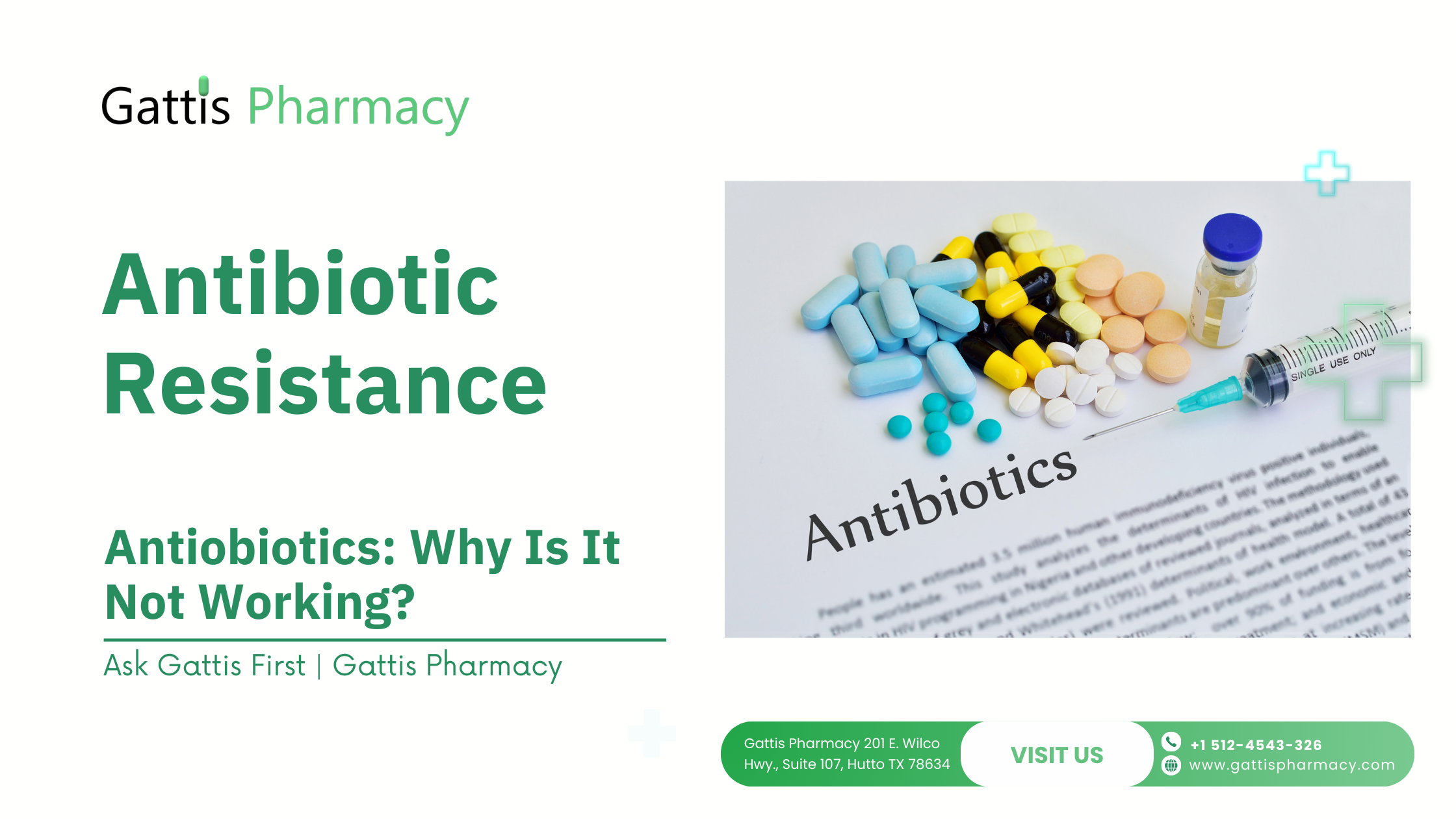Sometimes, people abuse drugs and that could leave the bacteria adapting and resisting medicines meant to fill them off – this becomes a case of Antibiotics Resistance.
Antibiotic resistance is a growing threat when bacteria adapt and resist medicines meant to kill them, leading to infections that are harder to treat, more severe, and sometimes deadly.
This Gattis Pharmacy guide will show what antibiotic resistance means, how misuse causes it, and what you can do to fight back.
What Is Antibiotic Resistance?
Antibiotic resistance occurs when bacteria change in response to exposure to antibiotics so that the drugs become less effective. The bacteria survive, multiply, and often develop the ability to resist more than one drug.
Because of this, illnesses that could once be treated easily may become stubborn, costly, and dangerous.
Antibiotic resistance also reduces the options doctors have, forcing use of stronger drugs which may have more side effects.
Causes: How Resistance Develops
Several practices contribute to antibiotic resistance:
- Overuse: Antibiotics used when not needed, for example for viral infections like the common cold or flu, provide unnecessary exposure. This exposure gives bacteria a chance to adapt.
- Incomplete courses: If you stop antibiotics early because you feel better, surviving bacteria (which may be more resilient) can cause relapse.
- Wrong antibiotic, wrong dose, wrong duration: Prescribing an antibiotic that isn’t effective for the bacteria (or using too low a dose, or not for long enough) leaves behind bacteria that survive and can mutate.
- Self-medication or sharing prescriptions: Using leftover antibiotics, sharing with others, or obtaining them without prescription increases misuse.
- Environmental & animal use: Antibiotic use in livestock, improper disposal of medicines, and environmental contamination all play a part in fostering resistant strains.
How Big Is the Problem in the U.S.
Here are recent statistics that illustrate how serious antibiotic resistance is:
- Every year in the U.S., there are more than 2.8 million antimicrobial-resistant infections. (CDC)
- These resistant infections lead to over 35,000 deaths annually. (CDC)
- The COVID-19 pandemic disrupted previous gains. Between 2019 and 2022, several hospital-onset resistant infections increased significantly. (CDC)
These numbers reflect disease burden but also show room for action — public health and individual behavior still make a difference.
Consequences of Resistance for You & Community
When antibiotics stop working:
- Infections take longer to heal and often need more medical interventions (longer hospital stays, more tests, risk of complications).
- Healthcare costs go up—stronger or more costly drugs, more follow-ups, sometimes more serious side effects.
- Some medical procedures become riskier (surgeries, transplants, chemotherapy) because they rely on antibiotics to prevent infections.
- Spread within community settings: resistant bacteria can transmit from person to person, from surfaces, or via food or environment.
What You Can Do: Steps to Reduce Risk
You can play a direct role in slowing antibiotic resistance:
- Only take antibiotics when prescribed by a healthcare provider. Don’t demand them if your condition is likely viral.
- Follow the full course of the antibiotics exactly as prescribed—time, dose, duration. Even if you feel better early, stopping can allow resistant bacteria to survive.
- Avoid using leftover antibiotics or someone else’s prescription. What worked for someone else may not work for you, and resistance patterns vary.
- Ask questions: Why is this antibiotic being prescribed? Is there sensitivity testing? Are there alternative treatments?
- Prevent infections in the first place: keep up on vaccinations, practice good hand hygiene, safe food handling, and clean wounds well.
How Gattis Pharmacy Helps
At Gattis Pharmacy, our role is to support you in making antibiotics work effectively when needed, and in avoiding misuse:
- We verify prescriptions, reviewing whether the antibiotic is appropriate for the suspected infection, whether the dose is correct, and whether the duration makes sense.
- We offer patient counseling so you understand why you’re taking the antibiotic, how to take it (with food, without food, times of day), what side effects to monitor, and why finishing the course matters.
- We encourage follow-up: if symptoms don’t improve, or if side effects or complications occur, we prompt you to check back with your healthcare provider.
- We provide guidance on safe disposal of leftover antibiotics, and avoid dispensing when the indication isn’t clear.
Moving Forward: Awareness & Stewardship
- Broader public health efforts include monitoring resistant bacteria, tracking data, developing new antibiotics, and guidelines for using them wisely.
- Stewardship programs in hospitals and community settings focus on reducing unnecessary antibiotic prescribing and ensuring correct use.
- Individual awareness matters: every time you take or prescribe antibiotics, there’s a chance to contribute to resistance unless done responsibly.
Conclusion
Antibiotic resistance is a growing health challenge, but with the right knowledge and responsible use of medications, we can all play a role in fighting it. At Gattis Pharmacy, our expert team is here to guide you on safe antibiotic use and provide trusted care that puts your health first.

